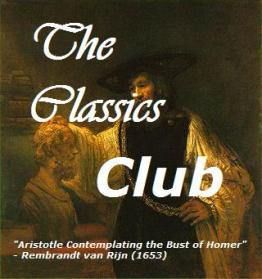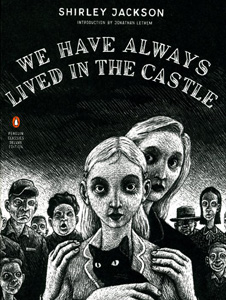 Gothic literature features characteristics such as magic, mystery, chivalry, horror, clanking chains, ghosts, and dark castles to create a spooky atmosphere rife with foreboding and possibility. Over time Gothic emphasis changed from reliance on these external trappings for their own sake to a focus on the inner workings of the human psyche that the Gothic atmosphere represents. Shirley Jackson’s deliciously creepy 1962 novel We Have Always Lived in the Castle demonstrates the power of the Gothic in the hands of a master craftsman.
Gothic literature features characteristics such as magic, mystery, chivalry, horror, clanking chains, ghosts, and dark castles to create a spooky atmosphere rife with foreboding and possibility. Over time Gothic emphasis changed from reliance on these external trappings for their own sake to a focus on the inner workings of the human psyche that the Gothic atmosphere represents. Shirley Jackson’s deliciously creepy 1962 novel We Have Always Lived in the Castle demonstrates the power of the Gothic in the hands of a master craftsman.
Brief History of Gothic Literature
The first Gothic novel was Horace Walpole’s Castle of Otranto (1764), set in a medieval castle featuring dark stairways, mysterious rooms, trap doors, and underground passages. Between 1789 and 1797 Anne Radcliffe wrote five romances, the most famous being The Mysteries of Udolpho, that helped make the form popular. Radcliffe emphasized setting and story over character.
As the Gothic novel spread across Europe, it became the backdrop against which authors examined the relationship between humans and the supernatural, with Mary Wollstonecraft Shelley’s Frankenstein (1818) perhaps the best known example. Gothicism also influenced other literary forms, particularly poetry of the romantic period in works by Coleridge, Wordsworth, Byron, and Keats. In the United States Charles Brockden Brown took up the form of the Gothic novel with Wieland (1798) and five subsequent romances.
Early Gothic novels focused on creating a spooky setting appropriate for a story of suspense, dread, foreboding, and, finally, terror. As Gothicism developed, it incorporated elements of the psychological that allowed a focus on character as well as on setting, as evident in the works of Nathaniel Hawthorne and Edgar Allan Poe. Still later works such as Charlotte Brontë’s Jane Eyre (1847) and Daphne du Maurier’s Rebecca (1938) employ literary devices that developed from the Gothic novel.
The British Library is currently presenting an exhibition entitled Terror and Wonder: The Gothic Imagination:
Beginning with Horace Walpole’s The Castle of Otranto, Gothic literature challenged the moral certainties of the 18th century. By exploring the dark romance of the medieval past with its castles and abbeys, its wild landscapes and fascination with the supernatural, Gothic writers placed imagination firmly at the heart of their work – and our culture.
In a magazine article about the exhibition:
Lead curator of the exhibition, Tim Pye, says: “Gothic is one the most popular and influential modes of literature and I’m delighted that Terror and Wonder is celebrating its rich 250 year history. The exhibition features an amazingly wide range of material, from stunningly beautiful medieval artefacts to vinyl records from the early Goth music scene, so there is truly something for everyone”.
We Have Always Lived in the Castle
 Jackson, Shirley. We Have Always Lived in the Castle
Jackson, Shirley. We Have Always Lived in the Castle
Penguin Books, 1962
Mary Katherine, known as Merricat, Blackwood is the first-person narrator of the story. In the opening paragraph she tells us that she is 18 years old and that she lives with her sister Constance: “I like my sister Constance, and Richard Plantagenet, and Amanita phalloides, the deathcup mushroom. Everyone else in my family is dead” (p. 1).
This final sentence of the opening paragraph signals the story’s Gothic emphasis. Although Richard Plantagenet could be any one of several English noblemen, context suggests that Merricat is referring to England’s King Richard III (1452–1485), who is famously believed to have ordered the murder of his two young nephews in the Tower of London. The themes of murder and a family power struggle emerge from this reference. These themes and Merricat’s admitted fondness for a deadly mushroom sharpen our expectations and foreshadow the rest of the story.
Gradually the backstory emerges: Six years earlier the rest of the Blackwood family had died of arsenic poisoning during a family dinner. The dead included Mr. and Mrs. Blackwood (Constance and Merricat’s parents), the girls’ 10-year-old younger brother, and their aunt, whose husband, Uncle Julian, their father’s brother, became very ill but recovered. Uncle Julian was damaged both physically and mentally by his brush with death. Now wheelchair-bound, he lives with Merricat and Constance and is completely dependent on Constance, who takes care of him while her sister largely watches.
Merricat was not at the dinner table that fateful night because she was being punished by having to spend the night in her room without any dinner. That dinner included berries, on which the diners sprinkled sugar that had been laced with arsenic. Suspicion fell on Constance, who did not eat berries and therefore didn’t get sick. She was tried and acquitted of the murders.
This brief outline of the backstory illustrates Jackson’s use of Gothic elements. In addition to the emphasis on death and the sense of foreboding and further impending doom, there are also Gothic overtones in the characterization of Merricat. She goes into the village twice a week for supplies, mostly food and library books, because Constance is agoraphobic. But Merricat must make a game of the trip, with rules about where she should walk and how she should act: “I forced my hands to be still and made a rule for myself: Whenever I saw a tiny scrap of paper I was to remember to be kinder to Uncle Julian” (p. 16). In addition to all her rules for herself, Merricat also buries things around the family property for good luck and even tacks a book up on a tree as a protective talisman. Such actions are examples of magical thinking, the belief that thinking is the same as doing. Magical thinking is normal in young children, who believe that their thoughts and desires cause events that happen around them. But the persistence of magical thinking in the 18-year-old Merricat suggests a deranged mind, another common Gothic element.
Merricat also continues the belief, apparently learned from her parents, that the Blackwoods are better than the villagers and should maintain their distance to avoid contamination from the less worthy:
All of the village was of a piece, a time, and a style; it was as though the people needed the ugliness of the village, and fed on it… . whatever planned to be colorful lost its heart quickly in the village. The blight on the village never came from the Blackwoods; the villages belonged here and the village was the only proper place for them. (p. 8)
Mr. Blackwood put up a fence all around the property and fastened it with a padlock. Merricat makes a ritual out of unlocking and relocating the gate when she leaves the house and when she returns from the village. The Blackwoods’ geographical isolation reflects their feelings of superiority and their fear of the masses:
I always stood perfectly straight and stiff when the children came close, because I was afraid of them. I was afraid that they might touch me and the mothers would come at me like a flock of taloned hawks; that was always the picture I had in my mind—birds descending, striking, gashing with razor claws. (p. 10)
Merricat’s narration of her family’s isolation from the villages bleeds into another Gothic element of the story, its setting. The isolation of the large Blackwood house, fenced off from the everyday world and fortified by Merricat’s magic, fits right into the Gothic picture. Jackson also uses setting to call up another work of late Gothic literature:
The Rochester house was the loveliest in town and had once had a walnut-panelled library and a second-floor ballroom and a profusion of roses along the veranda; our mother had been born there and by rights it should have belonged to Constance. (p. 4)
The Rochester house alludes to Mr. Rochester’s huge house, with his deranged wife hidden upstairs, in Charlotte Brontë’s 1847 novel Jane Eyre.
Gothic features continue as the plot of We Have Always Lived in the Castle unfolds. The precipitating crisis of the book occurs when Constance and Merricat’s cousin, Charles Blackwood, their father’s brother’s son, arrives to disturb the status quo of their existence. As the only remaining male heir, he intends to take over the family mansion and the family fortune. Merricat ratchets up her magic to protect her existence. When a fire breaks out at the house, the volunteer firefighters arrive to try to put it out. That is, after all, their job, even if they don’t like the Blackwoods, the fire chief insists. A truly macabre scene, suggestive of a Satanic ritual, develops as the townspeople implore the firefighters to let the house burn, then set to smashing and looting whatever the flames don’t destroy.
The fire obliterates the top floor of the house. Afterwards, Constance and Merricat continue to live in the small kitchen area while vines overgrow the top. Whereas Merricat had earlier spoken of their home as the house, now she describes it this way: “Our house was a castle, turreted and open to the sky” (p. 177). Finally, the story comes full circle as the house turns into the isolated, creepy castle characteristic of Gothic literature and all the foreboding of impending doom foreshadowed at the beginning comes to fruition.
© 2014 by Mary Daniels Brown
Addendum
See also Happy 250th, Ann Radcliffe:
It’s 250 years since the publication of The Castle of Otranto, an anniversary prompting both a British Library exhibition (Terror and Wonder: The Gothic Imagination) and a linked BBC Gothic season. It is Horace Walpole’s only novel that you see on entering the exhibition, and with which Andrew Graham-Dixon’s BBC4 series, The Art of Gothic: Britain’s Midnight Hour (which ends on3 November), began.
Another 250th anniversary, of Ann Radcliffe’s birth, goes unmentioned, an omission reflecting her curious marginalisation in both celebrations – “the great enchantress”, as Thomas De Quincey called her, does figure, but mainly as the hapless novelist (vapid and trashy, you infer) sent up in Northanger Abbey. For the British Library display, the problem looks to be the absence of a visual legacy, of Radcliffe manuscripts and film adaptations; for Graham-Dixon, it may be the absence of a penis. His blokeish version of early literary gothic consists of chaps like Walpole, William Bedford, Thomas Chatterton, Blake and De Quincey, with the equally colourful Mary Shelley as token woman, and their manly wrestlings with political and industrial revolution, masculine identity and urbanisation in turn influence the Victorians.
